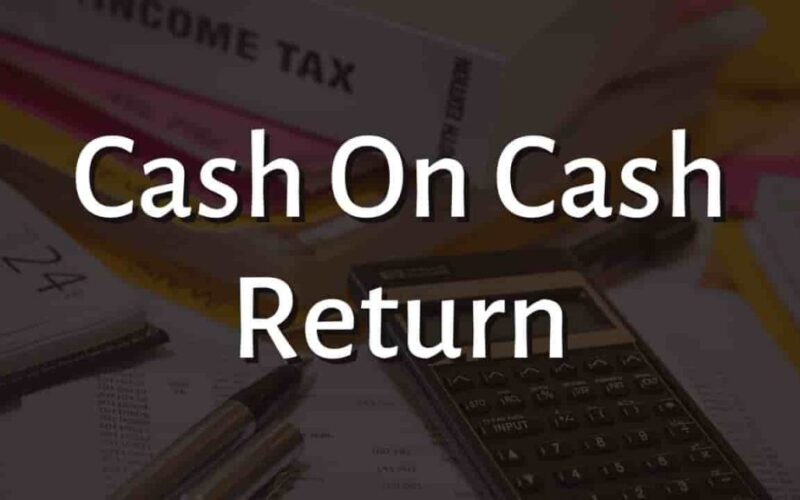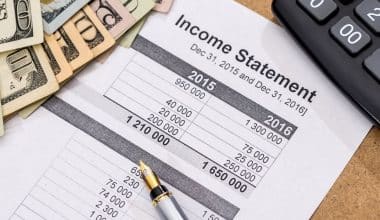Real estate investors are those that usually utilize cash on cash return to evaluate possible investment opportunities. With the investment calculator, I will be able to calculate the cash on cash return for a rental property and real estate with a rental property.
How to Calculate Cash on Cash Return
The cash on cash return is a rate of profit that calculates the total cash received on the overall cash (equity) spent in a transaction. How to calculate cash on cash in return for real estate or rental property or investment with the calculator is by dividing cash flow before tax in a particular period by the equity invested at the end of this process. The cash on cash return is a leveraged (after-debt) statistic, while the “free and clear” yield is its unleveraged counterpart.
The Cash On Cash Return Formula Is Straightforward and Easy
Annual Net Cash Flow / Invested Equity =
Cash on Cash Return
The cash on cash return is a rate of profit that calculates the total cash received on the overall cash (equity) spent in a transaction. You can calculate it by dividing it by cash flow before tax. particularly in a period when the equity is invested at the end of this process. The cash on cash return is a leveraged (after-debt) statistic, while the “free and clear” yield is its unleveraged counterpart.
In most cases, the cash-on-cash return is stated as a percentage. While this ratio can be applied in a variety of business situations, It is most typically utilized in commercial real estate transactions.
Why Cash on Cash Return Is So Important
when assessing a deal’s prospective profitability. The ability to calculate the cash on cash return on real estate or rental property or investment with the calculator is critical. This method can be a wonderful approach to predicting how an investment will do and, as a result, help you decide whether or not to invest. Moreover, calculating cash on cash return on real estate, rental property, or investment with the calculator can also steer investors in the proper direction when it comes to borrowings, such as when deciding between a regular mortgage and a private lender. The cash on cash return calculation may tell you which path will maximize your annual returns.
Many investors assess different investment assets using cash on cash returns. By comparing this indicator across properties, investors can have a better understanding of how each one will affect their total portfolios. Investors can also receive a consistent view of the long-term potential of multiple assets by depending on cash on cash returns as a comparison.
The Advantages of a Cash on Cash Return
Investors want to analyze a property’s cash on cash returns for a variety of reasons.
#1. Property Selection
The first and most practical application of cash-on-cash return is in property selection. Cash on cash return enables investors to do a fast, side-by-side comparison of several deals. According to the information at their disposal (i.e., the rent roll, operating expenses, and other financials provided by the seller),
#2. Cost Of Finance
Another reason investors prefer cash-on-cash return over other metrics is that it takes into account the cost of financing. This assists investors in determining what parameters are necessary to obtain specific cash on cash returns. when an investor has a larger stake in the deal (as a proportion of the loan-to-value). The cash on cash return is often lower than when an investor has a smaller stake in the deal. As more stock is invested, the computation skews lower, assuming revenues and costs remain constant otherwise. Of course, the cost of borrowing can have an impact on the cash-on-cash return. Hence, this calculation can encourage an investor to hunt around for better loan rates and terms.
Finally, cash on cash returns might shed light on a property’s spending profile. If all else is equal, properties with higher expenses will have lower cash on cash returns. A prospective buyer may examine existing expenses to see if there are any cost-cutting measures to boost cash on cash returns.
How Do Cash on Cash Returns Differ From Other Metrics?
How to calculate cash on cash return with the calculator is one of the indicators available to investors for evaluating investment opportunities. It also differs from other measures in the following ways:
#1. ROI vs. Cash on Cash
The return on investment (ROI) of a rental property is calculated to determine the overall rate of return on the property. including debt and cash, whereas cash on cash deals with how to calculate the return on the real estate cash (equity) invested.
#2. Internal Rate of Return (IRR) vs Cash on Cash
The IRR is defined as the total interest earned on money invested. The fundamental distinction between cash on cash returns and IRR is that IRR is calculated using total income earned during the ownership cycle. IRR calculations are substantially more difficult and are based on the financial idea of the time value of money.
#3. Cash on Cash vs. Cap Rate
The cap rate calculation is according to the assumption that there is no debt on the property. If a property is purchased entirely with cash (no debt service obligation). Then the cash on cash return is the same as the cap rate. However, because most investors utilize some form of leverage, these estimates are often different.
Are Cash-On-Cash Return and ROI the Same Thing?
When debt is utilized in a real estate transaction. The terms cash-on-cash return and ROI (return on investment) are not interchangeable. The majority of commercial properties are debt-financed. And the actual cash return on investment varies from the typical return on investment (ROI). ROI assesses the overall return on an investment, such as the debt burden. Cash-on-cash return, on the other hand, solely considers the return on the actual cash invested. Therefore allowing for a more precise assessment of the investment’s performance.
How to Calculate Cash-On-Cash for Rental Property
Basically, the how is that you calculate your cash-on-cash return for a rental property or real estate or investment by dividing your annual cash flow (pre-tax) by your entire cash investment.
To determine your pre-tax cash flow for the year, total up your gross rent intake. As well as any other revenue you may receive from the property. Such as additional rent for parking spaces or storage units. To calculate your net operating income, deduct your running expenses (property management, handyman, plumber, gardener. Plus other regular care) and annual mortgage payments (if you have one).
This number will be divided by the whole amount of money you originally purchased in the property, yielding your total cash invested. This could include your deposit, closing costs, and any repairs or renovations you performed before renting out the property. Your cash-on-cash return will be calculated as a percentage of the result.
So far your revenue from the rental property and investment in it stays constant. Then your cash-on-cash return will be roughly consistent. If your revenue rises as a result of being able to charge higher rent, your cash-on-cash return will rise as well. If you have to spend more money on an unexpectedly large repair, your cash-on-cash return will suffer.
Cash-On-Cash Return for Rental Property Examples
Let’s imagine you acquire rental property for a beautiful round number, say $300,000, and you have the funds to pay for it all at once. If you rent it out for $3,000 per month but have a $1,000 monthly upkeep cost. Then your yearly pre-tax cash flow is $24,000: ($3,000 – $1,000) x 12 months = $24,000. Divided by the amount of money invested ($300,000), the cash-on-cash return is 24,000/300,000, or 24 percent.
Assume another scenario in which the prospective investment is $200,000. Yet you sign out a mortgage with a 20% down payment ($40,000). The quarterly rental revenue and upkeep expenses remain the same as in the previous case. But you must now pay $1,000 toward your mortgage each month. That implies your pre-tax cash flow is $12,000: ($3,000 – $1,000 – $1,000) x 12, and your cash-on-cash return for rental property is 12,000/40,000, or just 30%.
What Is a Good Cash Cash Rate of Return?
Many investors are curious about what constitutes a good cash-on-cash return. There is no simple solution. Good cash on cash return is determined by a variety of factors, including an investor’s preferences. A risk-averse investor, for example, may choose to invest more equity in agreements, reducing the amount of leverage required.
The greater the amount of stock, the lower the leverage and cost of financing. And thus the lower the cash on cash return. For some investors, to calculate or know if an 8-10% cash on cash return is adequate is for the rental property to fit their other investing criteria using the calculator. Others may only consider transactions with minimum cash on cash return of 20%. To attain that barrier, these investors may need to use more debt and less equity.
The local market also has an impact on cash-on-cash returns. Higher acquisition costs may necessitate significantly more equity in very hot markets. (In total dollars, not as a percentage of loan-to-value). The overall cash on cash return may be lower unless the income is comparably large. Many investors, particularly those who are risk-averse and/or have a long investment horizon. They are willing to tolerate lower cash on cash return in primary markets with good underlying economics.
One technique for an investor to evaluate deals using cash on cash returns is to assume that each business has the same amount of equity invested in it. Assume an investor has $2 million to put into the market. They can put that $2 million into three different investments. The investor can evaluate which of the three deals resulted in the highest or “best” cash on cash return. According to the debt, income, and expenses connected with each of those deals provided the equity invested remains constant.
Internal Rate Of Return (IRR)
The IRR assesses an investment’s profitability throughout the life of the investment. Most industrial real estate investments take years to complete the full cycle (acquisition, improvement, and disposition). And IRR can show the expected return throughout that time. In other words, IRR can inform you how long the sponsor expects you to wait to get your money back.
Equity Multiply
The equity multiple (Nx) is a basic indicator that shows how much money the enterprise returned to its shareholders. A project with a 1x equity multiple broke even — it did not lose money or make a profit. As a result, $100,000 means $100,000 is refunded. A project with a 2x equity multiple twice your initial investment, and so on.
The equity multiple is calculated as (total profit + cash invested)/cash invested.
Equity multiple, like cash-on-cash return, does not compensate for the time value of money, whereas IRR does. Assume you’re thinking about investing in two hotels. The first investment has a 2.5x equity multiple, while the second investment has a 1.5x equity multiple. Based on the numbers alone, the first appears to be the better option.
Nevertheless, if the first investment takes 10 years to return your capital. And the second investment takes five years. The second investment may be a superior choice, even if the multiple is lower. In these cases, IRR and a projected annual distribution schedule might be quite valuable in informing your decision.
Aside from its limitations, the equity multiple is perhaps the most relevant indicator. Because it indicates the predicted total return on investment.
Conclusion
Finally, cash on cash return is a metric that can help investors assess which investments will be more or less profitable when contrasted to others. Presuming the same equity can be invested in various methods (including but not limited to real estate investments).
HOW TO CALCULATE CASH ON CASH RETURN FAQ
What is a good cash-on-cash return calculator?
The larger the proportion, the higher the investment and the greater the annual profit.
How do you calculate cash-on-cash return bigger pockets?
To calculate the cash-on-cash return is straightforward. You just have to simply divide the net cash flow obtained for the year by the amount of money invested.
Is 8% cash-on-cash return good?
Generally, most specialists think that cash on cash return of 8-12 percent is good cash on cash return. on the other hand, the calculation is based on a certain property.
What is the formula for determining cash-on-cash return
Annual Net Cash Flow / Invested Equity equal to Cash on Cash Return
The cash on cash return is a rate of profit rate that calculate the total cash received on the overall cash (equity) spent in a transaction. You can calculate it by dividing cash flow before tax. Particularly in a period by the equity invested at the end of this process.
What is a high cash-on-cash return?
There are no hard and fast criteria for determining what constitutes a high return rate. Investors appear to agree that projected cash on cash return of 8 to 12 percent signals a worthwhile investment.






